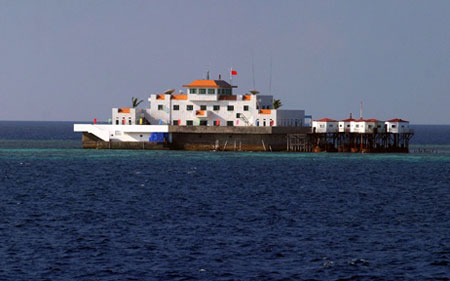
PLA General Advises Building Bases in the South China Sea
Publication: China Brief Volume: 9 Issue: 13
By:

The sixth meeting of the 11th National Committee of the Chinese People’s Political Consultative Conference’s (CPPCC) Standing Committee, the highest-level advisory body of the People’s Republic of China, met ahead of the general plenary that is taking place in Beijing from June 22 to 27. During one of the committee’s working group meetings on June 18, the former deputy chief of the General Staff of the People’s Liberation Army (PLA) and standing committee member of the CPPCC, General Zhang Li, recommended that China build an airport and seaport on Mischief Reef located in the Spratly Islands in the South China Sea. The additional facilities, Zhang said, would enable China to conduct aircraft patrol of the area, support Chinese fishing vessels and demonstrate the country’s sovereignty over the disputed islands (Ming Pao [Hong Kong], June 22). The call for building military installments on the disputed islets by General Zhang, a senior high-ranking military officer, may be signs of China’s increased willingness to use force in resolving territorial disputes as tension between China and ASEAN-member states (i.e. Philippines, Vietnam) boil over the contested islets in the region.
A Chinese media source reported that the PLA Navy, under the direct order of the Central Military Commission (CMC) under President Hu Jintao, recently conducted a large scale naval exercise in the South China Sea to demonstrate Chinese sovereignty over the islands. China officially imposed a fishing ban in the South China Sea on May 16 to reportedly prevent "over fishing," and sent eight patrol ships to monitor 128,000 square kilometers of the region (China Review News, June 19, Xinhua News Agency, June 9).
In recent months, tensions flared between China and Vietnam, which is one of the claimants contesting sovereignty over the islands, and Hanoi reportedly signed a $1.8 billion deal with Russia for six Kilo-class submarines in what analysts say appears to be the strongest response sent by Hanoi toward Beijing for what it increasingly sees as China’s encroachment on the South China Sea islands (Ria Novosti, April 27). The submarines, which are designed for anti-sub and anti-ship warfare, could help protect Vietnamese claims in the South China Sea by denying access to its more than 2,000 miles of coastline. The submarine has a displacement of 2,300 tons, a maximum depth of 350 meters (1,200 feet), a range of 6,000 miles, and is equipped with six 533-mm torpedo tubes (Ria Novosti, April 27).
In his remarks at the committee meeting, Zhang described the situation in the South China Sea as "very grim," and recommended that the Chinese navy add vessels and boats that have a displacement of 3,000 tons or higher for the navy and naval police that operate in the disputed area (Ta Kung Pao [Hong Kong], June 18). According to Zhang, the PLAN only has eight operational naval vessels that are deployable to the region, and these vessels are usually executing other missions in different areas, thus their capability to respond to any contingency that develops in the South China Sea is very limited (Ta Kung Pao, June 18). If the airport and seaport are constructed, Zhang said that China will then be able to control the Spratlys and provide a platform for Chinese naval vessels to bypass the Straits of Malacca, which Chinese military strategists consider a strategic choke point for the country’s national security.
The Spratly Islands are comprised of over 500 islets, while Vietnam occupies 29 of these islets; the Philippines, Malaysia and Brunei occupy three or more islets each, and the General noted that China only controls four of these islets (Ta Kung Pao, June 18). Moreover, according to Zhang, China does not possess a single oil well in the area, but other countries have more than 1,000 wells that extract from 5,000 to 1 hundred million barrels of oil per year. In response, Zhang advised Beijing to increase its investment in naval surface ships, satellite surveillance, intelligence facilities and basing construction in the region, while expanding oil exploration and production in the South China Sea (China Review News, June 19).





